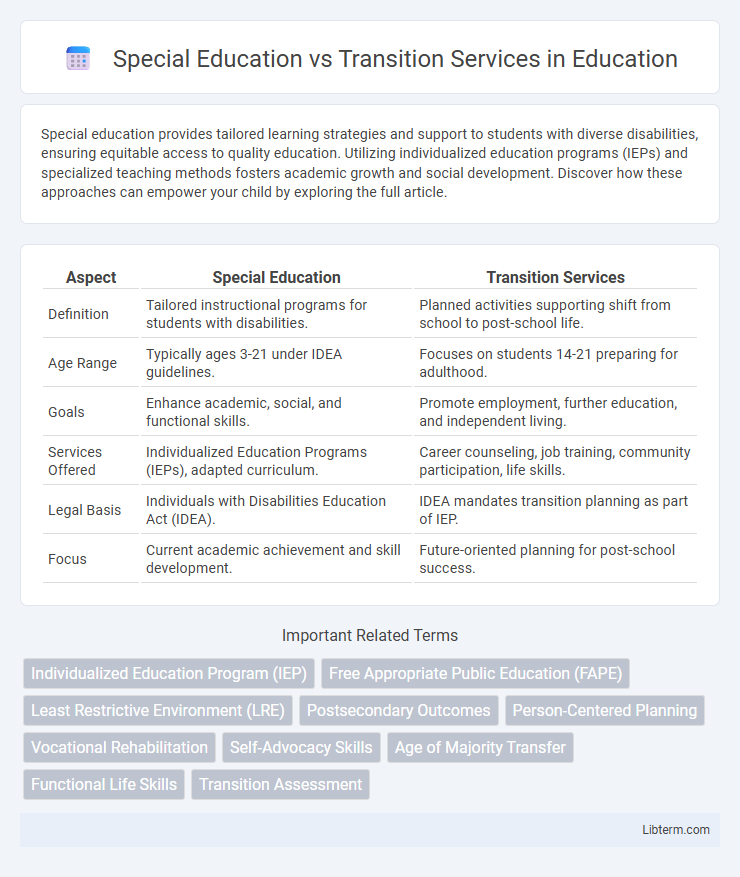Special education provides tailored learning strategies and support to students with diverse disabilities, ensuring equitable access to quality education. Utilizing individualized education programs (IEPs) and specialized teaching methods fosters academic growth and social development. Discover how these approaches can empower your child by exploring the full article.
Table of Comparison
| Aspect | Special Education | Transition Services |
|---|---|---|
| Definition | Tailored instructional programs for students with disabilities. | Planned activities supporting shift from school to post-school life. |
| Age Range | Typically ages 3-21 under IDEA guidelines. | Focuses on students 14-21 preparing for adulthood. |
| Goals | Enhance academic, social, and functional skills. | Promote employment, further education, and independent living. |
| Services Offered | Individualized Education Programs (IEPs), adapted curriculum. | Career counseling, job training, community participation, life skills. |
| Legal Basis | Individuals with Disabilities Education Act (IDEA). | IDEA mandates transition planning as part of IEP. |
| Focus | Current academic achievement and skill development. | Future-oriented planning for post-school success. |
Understanding Special Education: Key Concepts
Special education provides tailored instructional strategies and support to students with disabilities, ensuring access to a free appropriate public education (FAPE) as mandated by the Individuals with Disabilities Education Act (IDEA). It includes individualized education programs (IEPs) that specify academic goals, accommodations, and related services designed to meet each student's unique needs. Transition services are a component of special education focused on preparing students for post-secondary life, including employment and independent living, starting by age 16 in the IEP process.
What Are Transition Services?
Transition services are a coordinated set of activities designed to prepare students with disabilities for post-secondary life, including employment, higher education, and independent living. These services encompass instruction, community experiences, related services, and development of employment and other adult living objectives. Transition planning is tailored to each student's needs, strengths, and interests, ensuring a smooth shift from special education programs to adult roles.
Legal Framework: IDEA and Transition Planning
The Individuals with Disabilities Education Act (IDEA) establishes the legal framework requiring public schools to provide Special Education services tailored to students with disabilities, including transition planning starting by age 16. Transition services under IDEA focus on preparing students for post-secondary education, employment, and independent living through individualized, outcome-oriented plans. Compliance with IDEA ensures coordinated efforts between educators, families, and agencies to facilitate successful transitions from school to adult life.
Goals and Objectives: Special Education vs. Transition Services
Special Education focuses on providing individualized instruction and support to help students with disabilities meet academic, social, and functional goals within the school environment. Transition Services aim to prepare students for post-secondary life by developing objectives related to higher education, employment, and independent living skills. Both approaches emphasize tailored goals, but Special Education centers on current academic achievement, while Transition Services target future adult outcomes.
Assessment and Eligibility Criteria
Special Education assessment evaluates a student's cognitive, academic, and social-emotional functioning to determine eligibility based on IDEA criteria, identifying specific disabilities affecting learning. Transition Services assessment focuses on post-secondary goals, utilizing vocational, functional, and independent living evaluations tailored to the student's strengths, preferences, and interests in preparation for adulthood. Eligibility for Special Education is based on documented disabilities impacting educational performance, whereas Transition Services eligibility requires a formal individual transition plan (ITP) starting by age 16, aligning assessments with future employment, education, and independent living outcomes.
Individualized Education Programs (IEPs) and Transition Services
Individualized Education Programs (IEPs) provide a tailored educational plan addressing the unique needs of students with disabilities, ensuring access to appropriate special education services. Transition Services are specialized components within an IEP designed to prepare students for post-secondary life, including employment, independent living, and further education. Effective coordination between IEP goals and Transition Services supports smooth progression from school to adult environments for students with disabilities.
Service Delivery: In-Class Support vs. Community Integration
Special education primarily provides tailored in-class support, including individualized instruction and accommodations to address students' unique learning needs within the school environment. Transition services emphasize community integration by preparing students for life beyond school through vocational training, social skills development, and access to community-based resources. This shift from classroom-focused support to real-world applications enhances independence and facilitates smoother transitions into post-school settings.
Roles of Educators and Support Teams
Educators in special education develop individualized education programs (IEPs) tailored to students' unique learning needs, ensuring access to appropriate resources and accommodations. Transition services teams collaborate to equip students with skills for post-secondary education, employment, and independent living, facilitating a seamless shift from school to adulthood. Support teams, including special educators, counselors, and family members, work collectively to monitor progress and adjust interventions, maximizing student outcomes throughout the educational continuum.
Family and Student Involvement in Planning
Family and student involvement in planning special education and transition services is critical for successful outcomes, ensuring individualized goals align with the student's strengths and preferences. Collaborative meetings encourage active participation, enabling families and students to advocate for specific supports and resources necessary for academic, social, and vocational success. Research shows that inclusive planning improves engagement, self-determination, and long-term independence for students navigating the shift from school to adult life.
Measuring Success: Outcomes of Special Education and Transition Services
Measuring success in special education and transition services involves tracking student progress toward individualized goals, including academic achievement, social skills, and post-school outcomes such as employment and independent living. Data collection methods such as IEP goal attainment rates, graduation rates, and post-secondary employment statistics provide quantifiable indicators of program effectiveness. Effective transition services demonstrate improved outcomes by facilitating skills development, community engagement, and successful integration into adult life for students with disabilities.
Special Education Infographic

 libterm.com
libterm.com